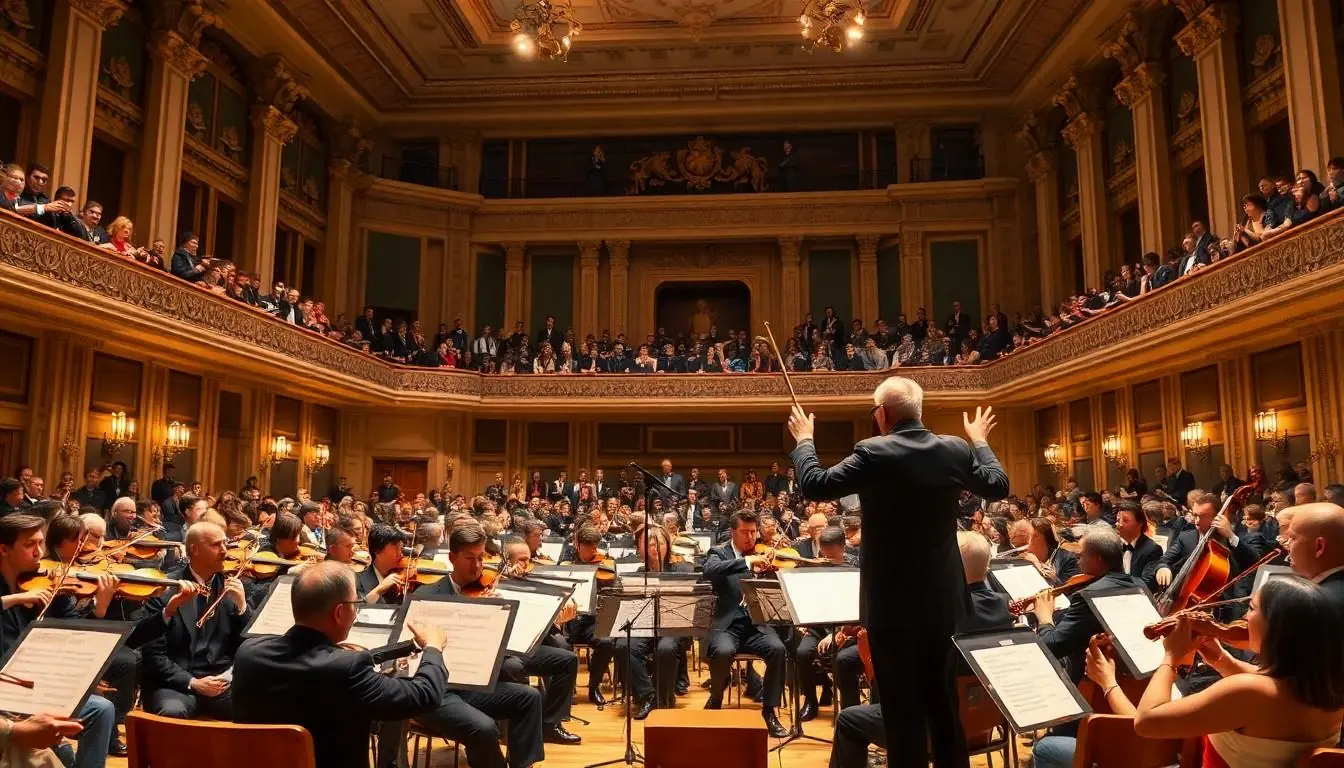Classical music might seem like a stuffy old relic, but it’s anything but boring. Imagine a world where emotions soar and stories unfold with every note. From the dramatic crescendos of Beethoven to the playful melodies of Mozart, classical music offers a treasure trove of examples that can transform any mundane moment into a symphonic experience.
Table of Contents
ToggleOverview of Classical Music Examples
Classical music encompasses various styles and important pieces that illustrate its emotional range and historical significance. Iconic examples include Beethoven’s Symphony No. 9, famous for its uplifting “Ode to Joy,” epitomizing triumph and unity. Mozart’s The Magic Flute showcases enchanting arias and vibrant orchestration, appealing to both children and adults.
Bach’s Brandenburg Concerto, with its intricate polyphony, displays mastery in composition and instrumental balance. Tchaikovsky’s Swan Lake captures emotional depth through its ballet score, illustrating the power of music in storytelling. Vivaldi’s The Four Seasons remains a staple, delighting listeners with its vivid depictions of seasonal changes.
Chopin’s Nocturnes highlight piano’s expressive capabilities. Debussy’s Clair de Lune transports listeners with its impressionistic textures, evoking a sense of nostalgia and reflection. Stravinsky’s The Rite of Spring revolutionized musical rhythm and form, making waves in the early 20th century.
Each example contributes to classical music’s rich tapestry, showcasing diverse compositions that thrill diverse audiences. The variety found within symphonies, concertos, chamber music, and operas serves to attract listeners from all walks of life. With its enduring appeal, classical music remains vital in contemporary culture, proving its relevance and vitality.
Famous Classical Composers

This section highlights significant classical composers who shaped the genre through their unique musical contributions.
Johann Sebastian Bach
Bach stands as a pivotal figure in classical music history. Known for his intricate counterpoint, he mastered form and structure. His works, such as the Brandenburg Concertos and Mass in B minor, exemplify both technical brilliance and emotional depth. Bach’s ability to blend different musical styles has influenced countless composers. Masterpieces like The Well-Tempered Clavier showcase his proficiency with keyboard instruments. His fugues demonstrate the complexity that captures listeners’ imaginations across generations.
Ludwig van Beethoven
Beethoven revolutionized classical music with his innovative compositions. His symphonies, particularly Symphony No. 9, broadcast powerful emotions and strong themes of hope. This work includes the famous Ode to Joy, uniting diverse voices in celebration. Beethoven expanded the symphonic form, pushing boundaries of expression. Other significant compositions, like Moonlight Sonata, highlight his unique ability to convey profound human feelings. The composer’s transition from classical to romantic styles also marks his influence on future generations of musicians.
Wolfgang Amadeus Mozart
Mozart exemplifies classical elegance and melodic beauty. Renowned for his prolific output, he created over 600 compositions, including operas, symphonies, and chamber music. Works such as The Marriage of Figaro and Symphony No. 41 showcase his remarkable versatility. Lightness and grace permeate much of his music, attracting audiences across varied ages. The Requiem Mass in D minor reveals his depth, as it reflects profound themes of life and death. Mozart’s enduring legacy defines classical music, inspiring musicians and listeners worldwide.
Notable Classical Music Pieces
Classical music features iconic works that showcase its emotional depth and complexity. Several categories highlight the diversity within this genre.
Symphonies
Symphonies exemplify orchestral grandeur and social commentary. Beethoven’s Symphony No. 9 stands out for its “Ode to Joy,” expressing universal brotherhood. Tchaikovsky’s Symphony No. 6, “Pathétique,” conveys deep feelings of despair and longing. Dvořák’s Symphony No. 9, “From the New World,” draws inspiration from American folk music, blending cultures in its thematic elements. These symphonies not only entertain but also provoke thought, reflecting their historical and cultural contexts.
Concertos
Concertos showcase the dialogue between solo instruments and orchestras. Vivaldi’s “The Four Seasons” brings nature’s seasons to life through vivid musical storytelling. Mozart’s Piano Concerto No. 21 captures elegance and charm while exhibiting virtuosic piano techniques. Beethoven’s Piano Concerto No. 5, known as the “Emperor Concerto,” combines power with lyrical beauty. Each concerto often highlights the prowess of featured soloists, creating captivating interactions that engage listeners.
Chamber Music
Chamber music emphasizes intimate performances with smaller ensembles. Works like Beethoven’s String Quartet No. 14 display intricate interplay and emotional expression. Schubert’s Piano Quintet in A major, also known as “The Trout,” combines lyrical themes with playful motifs. Dvořák’s Piano Quintet No. 2 utilizes rich harmonies and folk influences, creating a warm atmosphere. These pieces often allow musicians to explore deeper connections, showcasing the intricate relationship among players and their instruments.
The Influence of Classical Music
Classical music profoundly shapes modern genres, inspiring countless artists across various styles. Its emotive power resonates in film scores, pop songs, and even electronic music. Films like The King’s Speech and Amadeus prominently feature classical compositions to evoke emotions, demonstrating its cinematic significance.
Educational settings embrace classical music as a tool for enhancing cognitive abilities. Studies indicate that exposure to classical pieces, such as Mozart’s works, can improve spatial-temporal reasoning and learning outcomes. Music education programs incorporate classical training, laying a foundation for future musicians and enriching a child’s musical appreciation.
Cultural rituals often include classical pieces, maintaining traditions across generations. Weddings frequently feature composers like Pachelbel, whose “Canon in D” remains a favorite choice for bridal marches. Concerts, festivals, and community events celebrate classical music, fostering shared experiences and connections among attendees.
Many contemporary musicians draw inspiration from classical forms and structures, enriching their own compositions. Pop and rock artists, including Elton John and Lady Gaga, integrate orchestral elements and melodies reminiscent of classical traditions. The fusion of classical techniques with modern sensibilities reflects the genre’s ongoing relevance.
The accessibility of classical music increases through digital platforms and streaming services. Audiophiles discover works by Haydn, Schubert, and others with ease, making classical music more approachable to new audiences. Podcasts and playlists offer curated selections, inviting listeners to explore the vast repertoire and deepen their appreciation.
Overall, the influence of classical music extends far beyond its historical roots. Its emotional depth, adaptability, and accessibility ensure its enduring presence in the cultural landscape, continually inspiring new generations of artists and audiences.
Classical music remains a vital part of the cultural fabric. Its emotional depth and historical significance continue to resonate with audiences of all ages. The works of legendary composers like Beethoven, Mozart, and Bach not only showcase the genre’s rich diversity but also its ability to inspire modern musicians across various styles.
With the rise of digital platforms, more listeners can explore this timeless repertoire. Whether it’s the grandeur of a symphony or the intimacy of chamber music, classical compositions are sure to evoke feelings and spark creativity. As it evolves, classical music will undoubtedly maintain its relevance and impact in contemporary society.


